Before continuing I would like to thank Hans Polak for his assistance with LTSpice (hopefully everything is correct below), for his extensive feedback and for identifying some serious limitations in the network that were subsequently addressed. Note that the network has not yet been physically built, as being the next step.
The dynoFlee is a power diamond buffer driven by "flee" current from an input op-amp input. "Twin-turbo" reflects the use of a pair of complementary power feedback networks that operate independently on either half of the signal, that in combination feed into a diamond summing point through a pair of diodes created from bipolar transistors. These currents, in conjunction with complementary current dumping networks combine into a common load, resulting in a voltage signal across the load as a replicant of the input signal. Output errors are sensed by an op-amp with error current correction fed back into the input of the diamond for overall distortion reduction. Current limit protection is included.
The two screenshots below suggest the performance possibilities of the network and illustrate the operation. The left screenshot shows current limiting set to activate at about 9 Amps, this while attempting 40 volt swings into a 4 Ohm load (requires 10 Amps), with corresponding clipping distortion resulting in ~2% distortion. It also shows the 4 independant currents from Q3,Q4,Q5,Q6 feeding into the 4 Ohm load. The right screenshot shows current limit removed with the same input signal into a 4 Ohm load at ~200 Watts... result in ~0.0002% THD.
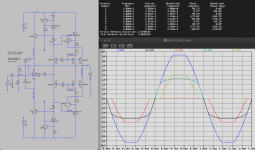
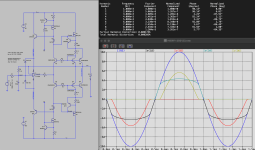
The frequency response ~500KHz on the left. On the right the output Ro with frequency tested with 1 Volt feeding back into the output through 1 Ohm, suggesting ~1m OHM @20 kHertz, ~100u Ohm @2 kHertz suggesting an extreme damping factor.
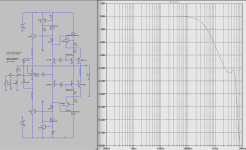
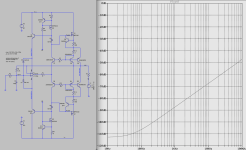
In power amplifiers it is often the case that power supplies are unregulated hence PSRR can be an important factor in design. Below are the PSRR's for 1 volt signals in the positive supply on the left, and negative supply on the right.
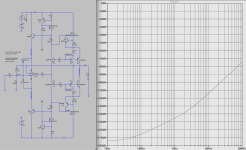
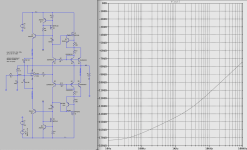
It should be noted that this network operates with higher quiescent current, ~250mA for the network above. Further, that with the inclusion of an appropriate input gain stage with loopback from the output, the overall performance can be improved by nesting the dynoFlee within the loop.
The dynoFlee is a power diamond buffer driven by "flee" current from an input op-amp input. "Twin-turbo" reflects the use of a pair of complementary power feedback networks that operate independently on either half of the signal, that in combination feed into a diamond summing point through a pair of diodes created from bipolar transistors. These currents, in conjunction with complementary current dumping networks combine into a common load, resulting in a voltage signal across the load as a replicant of the input signal. Output errors are sensed by an op-amp with error current correction fed back into the input of the diamond for overall distortion reduction. Current limit protection is included.
The two screenshots below suggest the performance possibilities of the network and illustrate the operation. The left screenshot shows current limiting set to activate at about 9 Amps, this while attempting 40 volt swings into a 4 Ohm load (requires 10 Amps), with corresponding clipping distortion resulting in ~2% distortion. It also shows the 4 independant currents from Q3,Q4,Q5,Q6 feeding into the 4 Ohm load. The right screenshot shows current limit removed with the same input signal into a 4 Ohm load at ~200 Watts... result in ~0.0002% THD.


The frequency response ~500KHz on the left. On the right the output Ro with frequency tested with 1 Volt feeding back into the output through 1 Ohm, suggesting ~1m OHM @20 kHertz, ~100u Ohm @2 kHertz suggesting an extreme damping factor.


In power amplifiers it is often the case that power supplies are unregulated hence PSRR can be an important factor in design. Below are the PSRR's for 1 volt signals in the positive supply on the left, and negative supply on the right.


It should be noted that this network operates with higher quiescent current, ~250mA for the network above. Further, that with the inclusion of an appropriate input gain stage with loopback from the output, the overall performance can be improved by nesting the dynoFlee within the loop.